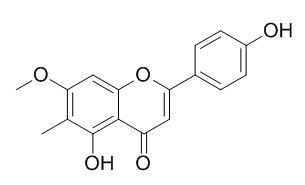8-Demethylsideroxylin
8-Demethylsideroxylin is a natural product from Eucalyptus robusta Smith.
Inquire / Order:
manager@chemfaces.com
Technical Inquiries:
service@chemfaces.com
Tel:
+86-27-84237783
Fax:
+86-27-84254680
Address:
1 Building, No. 83, CheCheng Rd., Wuhan Economic and Technological Development Zone, Wuhan, Hubei 430056, PRC
Providing storage is as stated on the product vial and the vial is kept tightly sealed, the product can be stored for up to
24 months(2-8C).
Wherever possible, you should prepare and use solutions on the same day. However, if you need to make up stock solutions in advance, we recommend that you store the solution as aliquots in tightly sealed vials at -20C. Generally, these will be useable for up to two weeks. Before use, and prior to opening the vial we recommend that you allow your product to equilibrate to room temperature for at least 1 hour.
Need more advice on solubility, usage and handling? Please email to: service@chemfaces.com
The packaging of the product may have turned upside down during transportation, resulting in the natural compounds adhering to the neck or cap of the vial. take the vial out of its packaging and gently shake to let the compounds fall to the bottom of the vial. for liquid products, centrifuge at 200-500 RPM to gather the liquid at the bottom of the vial. try to avoid loss or contamination during handling.
J of Ana. Chem.2019, 74(11):1113-1121
Processes2021, 9(1), 153.
BioResources J.2020, 15(3).
Eur Rev Med Pharmacol Sci.2020, 24(9):5127-5139.
Antioxidants (Basel).2023, 12(2):447.
Molecules.2024, 29(5):1050.
Int J Pharm.2022, 618:121636.
Evid Based Complement Alternat Med.2021, 2021:6687513.
Molecules.2022, 27(19):6681.
Int J Mol Sci.2023, 24(23):17118.
Related and Featured Products
Molecules. 2017 Mar 6;22(3). pii: E412.
Metabolite Profiling of Eastern Teaberry (Gaultheria procumbens L.) Lipophilic Leaf Extracts with Hyaluronidase and Lipoxygenase Inhibitory Activity.[Pubmed:
28272321 ]
The phytochemical profile and anti-inflammatory activity of Gaultheria procumbens dry lipophilic leaf extracts were evaluated.
METHODS AND RESULTS:
Forty compounds were identified by GC-MS, representing 86.36% and 81.97% of the petroleum ether (PE) and chloroform (CHE) extracts, respectively, with ursolic acid (28.82%), oleanolic acid (10.11%), methyl benzoate (10.03%), and methyl salicylate (6.88%) dominating in CHE, and methyl benzoate (21.59%), docosane (18.86%), and octacosane (11.72%) prevailing in PE. Three components of CHE were fully identified after flash chromatography isolation and spectroscopic studies as (6S,9R)-vomifoliol (4.35%), 8-demethyl-latifolin (1.13%), and 8-Demethylsideroxylin (2.25%). Hyaluronidase and lipoxygenase inhibitory activity was tested for CHE (IC50 = 282.15 ± 10.38 μg/mL and 899.97 ± 31.17 μg/mL, respectively), PE (IC50 = 401.82 ± 16.12 μg/mL and 738.49 ± 15.92 μg/mL), and nine of the main constituents versus heparin (IC50 = 366.24 ± 14.72 μg/mL) and indomethacin (IC50 = 92.60 ± 3.71 μg/mL) as positive controls. With the best activity/concentration relationships, ursolic and oleanolic acids were recommended as analytical markers for the extracts and plant material.
CONCLUSIONS:
Seasonal variation of both markers following foliar development was investigated by UHPLC-PDA. The highest levels of ursolic (5.36-5.87 mg/g DW of the leaves) and oleanolic (1.14-1.26 mg/g DW) acids were observed between August and October, indicating the optimal season for harvesting.



